Category: Deer Hunting
Patterning A Mature Buck
I grew up rabbit hunting. It was the game of choice as there wasn’t a deer season in the county where I was raised. One of my favorite pastimes was tracking or back tracking rabbits in the snow. I probably learned more about rabbits and rabbit hunting by back tracking rabbits in the snow than I did from anything else with the exception of invaluable lessons from my grandfather and father (they were incredible rabbit hunters). In hindsight, those lessons were of huge value to me as a deer biologist and hunter. I learned that critters need food, cover, and water and will use the path of least resistance to move from one to another AS LONG AS THEY DON’T FEEL THREATENED ALONG THOSE PATHS.
The same is true for mature bucks. They need food, cover, and water on a regular basis and will move between these resources along the path of least resistance as long as they don’t feel threatened. One of my hunting tactics is to determine if there are mature bucks in the area by using Reconyx cameras and then use aerial photos to locate the likely sources of food, cover, and water close to the camera that photographed the buck. Notice that I didn’t say I moved the camera to monitor the sources of food, cover, and water. One of my keys to success is being very aware of the bold words in the previous paragraph – AS LONG AS THEY DON’T FEEL THREATENED ALONG THOSE PATHS.
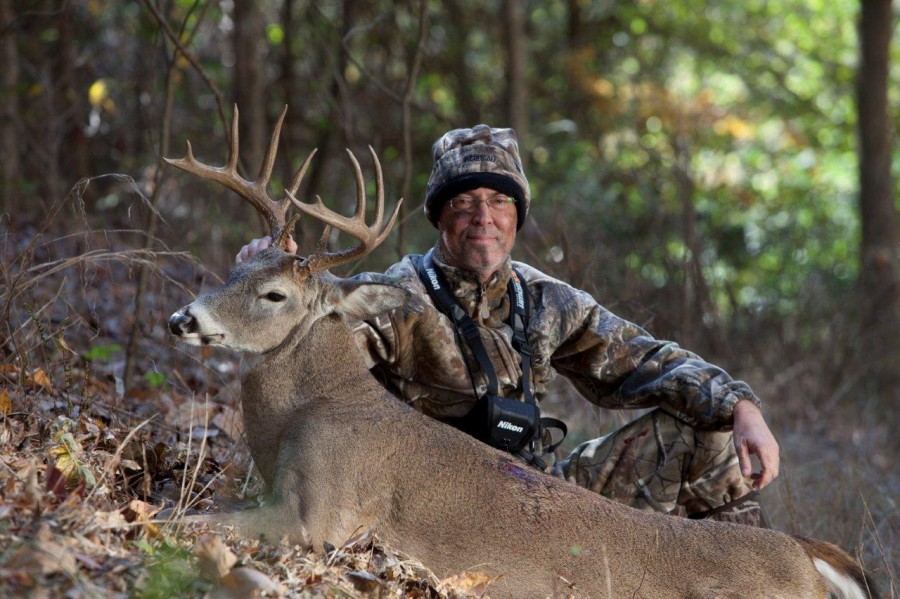
Most of my neighbors hunt and deer are constantly being alerted during the season in my neighborhood. I know deer will range off my property. However, I want to encourage them to spend as much time on my property during daylight hours as possible. That’s one reason why I created sanctuaries! Deer, even during the rut, will likely spend most of the day resting in thick cover. If I can protect bucks during the day, they will have a good chance of surviving to maturity. In addition, if mature bucks are conditioned to finding safety in the same area (sanctuaries), then it’s easier to pattern them.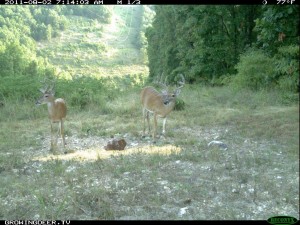
I used this strategy last Friday to kill a buck I had named Clean 12. It was a great hunt as I watched the buck for more than 10 minutes including watching him make a scrape, thrash some limbs with his antlers, and vocalize a snort wheeze. I ended up shooting Clean 12 at three yards! It was a thrilling hunt!! However, what made this encounter with Clean 12 work was simply applying the strategy outlined above.
I had obtained several Reconyx images of Clean 12 during the late summer. I placed some Reconyx cameras in open areas such as Trophy Rock stations and food plots to get a feel for his range and travel patterns.
I knew I wouldn’t likely hunt at any of those camera stations 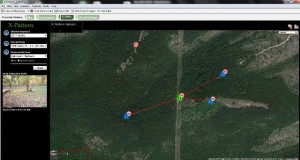 because they were in open areas. Mature bucks would rarely visit them during daylight once season opened. I then used my knowledge of the closest locations for food (used mainly at night by mature bucks this time of year), water (several springs and seeps in the area so no way to predict which source he might use), and cover.
because they were in open areas. Mature bucks would rarely visit them during daylight once season opened. I then used my knowledge of the closest locations for food (used mainly at night by mature bucks this time of year), water (several springs and seeps in the area so no way to predict which source he might use), and cover.
Years ago I had created a sanctuary at the east end of the area where I had images of Clean 12. It seemed the obvious bedding area for Clean 12 . It was the most limiting of three needs a deer has daily (food, water, and cover) in the portion of his range I had confirmed. In addition, I could approach from the east and not enter the area where I had patterned him mainly at night. A northwest, west, or southwest wind would be perfect for the area between where I knew Clean 12 was using and the sanctuary. This area is a de facto transition zone. Deer shouldn’t feel threatened moving into the sanctuary so the site I picked to hang my Muddy stands was the path of least resistance. Finally, the sanctuary was lower in elevation than the ridge where I had determined Clean 12 was using at night and the thermals would be pulling scent downhill (east) and away from where I predicted Clean 12 would be coming from toward the sanctuary.
With my plan in place, Adam (my cameraman) and I were able to approach our stands without alerting deer anywhere to the west of us. About 9 am, I spotted a buck 70 yards away moving toward the bedding area. The habitat work, placement of the Reconyx cameras, and Muddy stands had paid off. You can see the events that occurred when Clean 12 closed the last 70 yards on GDTV 101.
Growing (and hunting) Deer together,
Grant
Deer Movement Related to Weather
After 20+ years of collecting data as a scientist and as an avid deer hunter, it’s obvious that hunters see more deer when the weather is changing. The trends show that the more abrupt the changes in weather, the more likely hunters are to see deer.
My most memorable observation related to deer and changing weather occurred during September 1989. I was studying deer behavior associated with rubs near Charleston, South Carolina. Hurricane Hugo was predicted to come on shore and the storm’s eye was to pass within miles of my study site. While I was making one last round to check the cameras used to monitor the rubs before the storm, I saw mature bucks, does, and fawns literally everywhere during the day. I saw them in fields, in food plots, in yards – everywhere. I had permission to hunt the property where I was doing research, but thought the power might go out for a day or two and opted not to harvest a deer. The eye of the storm almost center-punched the property where I was working and electricity wasn’t restored for six weeks.
Unquestionably the deer sensed the magnitude of the coming change in weather better than me. Rather than thinking about hunting, I should have been driving out of the storm’s path! No one knows how deer sense a pending change in weather. Several researchers, including myself, have attempted to understand how deer detect pending changes in weather. No researcher has published a definitive reason why deer increase activity substantially before or after some substantial changes in the weather.
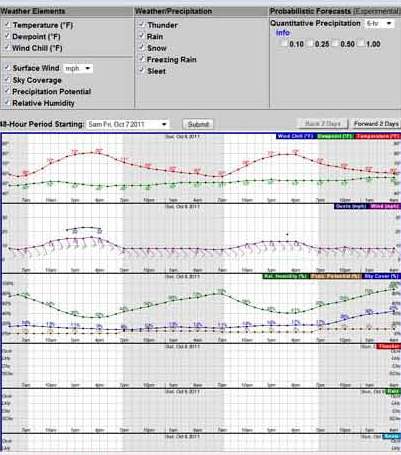 Weather can’t accurately be predicted more than a few days (or hours) in advance. I know this all too well as I prepare today to return from a hunting trip in Kansas. I planned this trip months ago. I’ve spent the better part of this week thinking about this as the weather has been hotter than normal (setting some records), very low humidity, and extremely dry. I’ve seen a few does and fawns daily, but no mature bucks. The owner of the property where I’m hunting told me yesterday that he didn’t have a single trail camera image of a mature buck moving during the daytime this past week. He did say “You should have been here last week.” Dang, I really dislike hearing that phrase in relation to hunting!
Weather can’t accurately be predicted more than a few days (or hours) in advance. I know this all too well as I prepare today to return from a hunting trip in Kansas. I planned this trip months ago. I’ve spent the better part of this week thinking about this as the weather has been hotter than normal (setting some records), very low humidity, and extremely dry. I’ve seen a few does and fawns daily, but no mature bucks. The owner of the property where I’m hunting told me yesterday that he didn’t have a single trail camera image of a mature buck moving during the daytime this past week. He did say “You should have been here last week.” Dang, I really dislike hearing that phrase in relation to hunting!
I enjoy hunting and visiting with friends. However, my mission was to pattern and harvest a mature buck. I think I patterned the activity of mature bucks in this part of Kansas – moving almost exclusively at night. I could have predicted this activity pattern based on the weather. I simply couldn’t predict the weather months in advance. Often, when planning hunting trips, the biggest limiting factor in the equation is that the weather at a specific location can’t be predicted with any degree of accuracy.
I enjoy hunting new areas, learning the lay of the land, etc. I enjoy taking off from the truck with nothing except my bow, a stand and a map. However, I’d probably enjoy it more if the weather was changing to conditions favorable for mature bucks to be active during daylight hours. I’ll hunt again this morning, and then pull my stands and head home. The weather is clear, dry, and warm – perfect for driving. I couldn’t have planned that part better!
Growing Deer together,
Grant
Deer Hunting and Scent Control: How Good is a Deer’s Nose?
Most hunters know that deer have a great sense of smell. However, it is very difficult for researchers to determine just how good a deer’s sense of smell is. We can’t put samples in front of a deer and ask them if they can detect this odor or chemical. However, earlier this week I indirectly witnessed an example of how well deer can smell.
I shot a doe in the liver with my bow. I reviewed the footage on a high quality HD camera (we were filming for GrowingDeer.tv). I knew the hit would be fatal, but the trailing job would be a bit longer than a deer shot in both lungs. We waited an hour then took up the trail, which was easy to follow for the first 100 yards. The doe then traveled through a grove of cedars and blood doesn’t show up very well on cedar needles. In Missouri, all possible means to recover a deer must be used before using a dog to trail. I felt we were at that point so I called the local conservation officer and obtained permission to use Crystal, our 18 month old lab. Tracy, my wife, has been training Crystal to follow blood trails.
Crystal was a bit confused at first given all of my scent, but eventually she picked up the trail. She trailed the doe through the cedars, across a food plot, across a dry creek, through chest high weeds along the creek, down a gravel road for 100 yards, then 50 yards into a thick bedding area. I was thrilled to see the doe piled up and gave Crystal several treats and plenty of “good girl” comments!!
Besides being thrilled to recover the doe, I was once again shown how well deer can smell. It’s generally assumed that prey species (deer included) have as good, if not a better, sense of smell than predator species (Crystal included). This is one reason prey species are able to survive.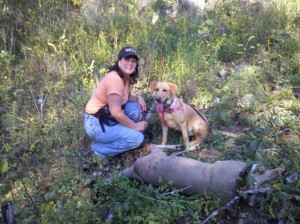
Several vehicles had driven the gravel road between when I shot and when Crystal trailed the doe down the gravel road. The humidity was low that day and because gravel is not porous it is not a good surface to hold scent. The gravel had been covered by vehicle exhaust, dripping oil, etc. Neither I, nor the folks helping, saw one drop of blood on the gravel road. Simply stated, Crystal was able to trail the deer in horrible conditions.
I share this event to illustrate how good a deer’s sense of smell is. It’s incredible! Based on this and gads of other similar observations, my hunting strategy has changed over the years to include reducing as much scent from my gear and myself as much as possible.
I start with a shower. I then dry myself with a clean towel that’s been laundered in scent free soap. My hunting clothes have been laundered with scent free soap also and stored in a barn that doesn’t have gas, etc., stored close by. I take my hunting clothes and gear to the field in clean tubs and change into them beside my truck just before I walk to my stand. Yes, it can be wicked cold changing in the field during the late season. I have a pair of boots I only use when I hunt. I never wear them inside my truck, let alone to go shopping, get gas, etc. I use the Dead Down Wind system because it is based on enzymes that destroy chemicals and bacteria that are the source of odors. Most scent control systems are only a bactericide – just one source of odors.
The effort involved to take these steps is worth it to me as I frequently watch deer cross the path I use to access my stand. In fact, I watched multiple deer cross the path the cameraman and I used to access my stand this past Wednesday, when I harvested two does. Multiple deer fed 270 degrees around the stand without giving any indication they smelled Adam (the cameraman), me, or our gear. It was a beautiful morning in the woods watching deer and bringing home some venison. I believe it occurred because Adam and I use a simple, but effective scent reduction system.
A deer’s sense of smell is amazing. However, by reducing the scent on me and my gear as much as possible by using a complete system, I have shown that I can keep from alerting deer to my presence. This is critical in the humid, swirling wind conditions where I live and hunt. During bow season, controlling my scent enough that deer may approach 10 yards closer can lead to more opportunities to draw back my bow.
I like watching Crystal work, but would rather watch her trail someone else’s deer. I’ll keep using my system and let my buddies know Crystal is available if they make a bad hit.
Growing Deer together,
Grant
Nocturnal Bucks
There is a buck at my place I call Pitch Fork. His rack has been odd shaped for the last three years that I have been tracking him. Actually without genetic testing, it is never 100% certain that a buck with a similar rack is the same from one year to the next. However, I feel very confident that the buck I called Pitch Fork in 2009 is the same buck I called Pitch Fork in 2010 and 2011.
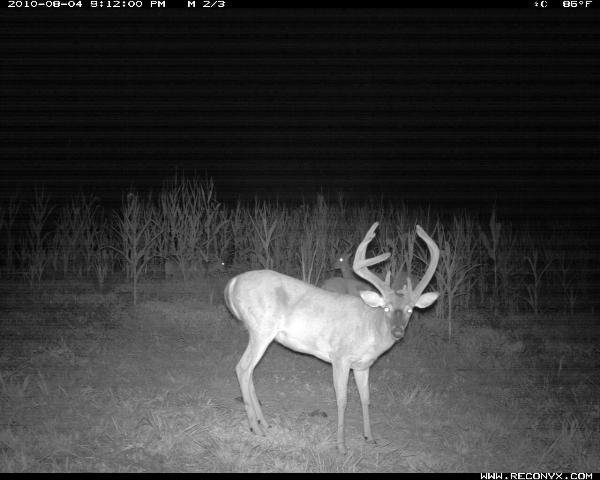 Not only has his rack remained in the same basic configuration, but his behavior hasn’t changed. He’s extremely nocturnal. My Reconyx cameras have taken images of Pitch Fork at the same three locations (relatively close together) for three years. Every Reconyx image of Pitch Fork is at night – every single one. The closest I’ve come to seeing Pitch Fork was last spring, when we found one of his shed antlers during our 2011 Shed Hunt.
Not only has his rack remained in the same basic configuration, but his behavior hasn’t changed. He’s extremely nocturnal. My Reconyx cameras have taken images of Pitch Fork at the same three locations (relatively close together) for three years. Every Reconyx image of Pitch Fork is at night – every single one. The closest I’ve come to seeing Pitch Fork was last spring, when we found one of his shed antlers during our 2011 Shed Hunt.
Pitch Fork is a buck that is high on my hit list simply due to his age and my frustration factor with him. I believe I know his core area from the images, finding of a shed, etc. However, I’ve never seen this buck during daylight while hunting (or simply working the land). 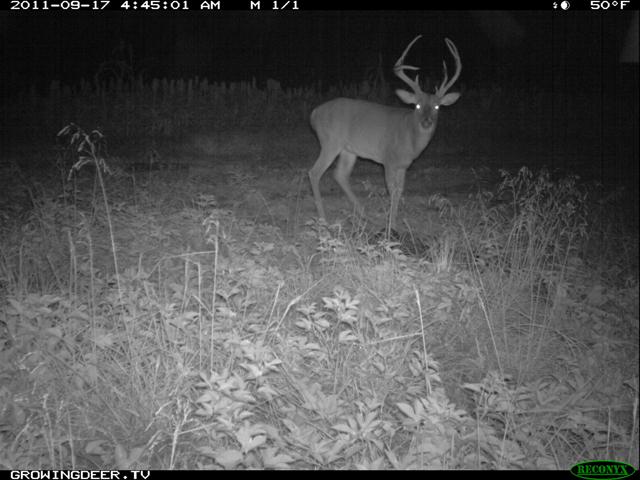 It seems he only moves at night.
It seems he only moves at night.
I’ve known of several bucks through trail camera and GPS collar studies that seemed almost unkillable using legal methods. However, even the most nocturnal of these bucks will move sometime during the daylight.
Like many of you, I can’t hunt every day. So, as much as I enjoy a challenge, I focus my hunting effort on mature bucks that show more sign of moving during the daylight hours based on observations and images from my cameras. Although I focus my hunting effort on mature bucks that are captured on trail cameras more during daylight, I am vigilant for chinks in the armor of nocturnal bucks like Pitch Fork. This strategy has proven successful for me on several occasions
If you are a hunter that enjoys attempting to pattern and hunt for specific bucks, be careful of which bucks you place on your hit list. Nocturnal bucks like Pitch Fork can lead to years of frustration. However, studying bucks like Pitch Fork can make you a better hunter. Such bucks have very few holes in their predator survival plan. Pitch Fork has taught me many lessons during the past three years. I’ll find out how much I learned when I hunt him this year. I’ll let you know my grade later this season.
Growing (and hunting) Deer together,
Grant
When to Harvest Does
Every year at this time I am frequently asked “When is the best time to harvest does?” This is not to be confused with the question “Should I harvest does?” Whether to harvest does or not should be based on the goals of the land owner and the balance of deer numbers and the habitat’s ability to produce/provide quality forage throughout the year. The more of deer’s genetic potential the land owners desire to be expressed the more important it is for each deer to have access to all the quality forage they will consume year round. I suspect that 99.9% of the problems folks perceive to be attributed to genetics with deer can be solved by providing better quality nutrition.
Once the doe harvest quota has been established, the best time to begin harvesting does is the first opportunity presented during legal hunting season!! There are several arguments that are commonly used against this strategy but the most common seems to be “the bucks will leave seeking does elsewhere.”
This is simply not true for the majority of mature bucks. I refer to Queen Isabella I to illustrate this point. Queen Isabella funded Columbus’ mission that resulted in discovering North America. Queen Isabella thought the world was flat. Columbus thought the world was round – that something better was past the area that was in current range.
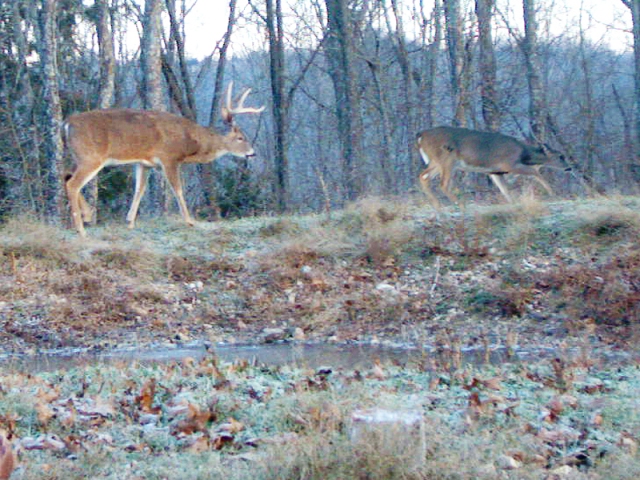 Based on tens and tens of thousands of points recorded by GPS collars on mature bucks, bucks share Queen Isabella’s theory that their world is flat and it is very dangerous outside of their known world. They have no idea if there are more or less does outside of their range. They certainly don’t know the wind thermals, threats, predators, hot spots, etc., outside their range. Most mature bucks that have been fitted with GPS collars from Texas to Minnesota to Maryland to Florida spend all or the vast majority of their days within the same home range. Some of these collared bucks have taken excursions and almost always return to their range in 24 or 48 hours. By any measure, mature bucks are homebodies.
Based on tens and tens of thousands of points recorded by GPS collars on mature bucks, bucks share Queen Isabella’s theory that their world is flat and it is very dangerous outside of their known world. They have no idea if there are more or less does outside of their range. They certainly don’t know the wind thermals, threats, predators, hot spots, etc., outside their range. Most mature bucks that have been fitted with GPS collars from Texas to Minnesota to Maryland to Florida spend all or the vast majority of their days within the same home range. Some of these collared bucks have taken excursions and almost always return to their range in 24 or 48 hours. By any measure, mature bucks are homebodies.
Based on all we know about deer and their use of senses and their ability to survive this makes sense. Deer would be extremely vulnerable to predators (2- and 4-legged) without great knowledge of the habitat and wind thermals.
To make bucks more active during the rut within their home range, it is best to reduce the number of does so each mature buck will search more to find a receptive doe. If the adult sex ratio is skewed toward does, a mature buck may spend most of his time “locked down” with a receptive doe and not be cruising/competing for a date.
I’ve experienced the benefits of hunting properties where the adult sex ratio was balanced or even skewed toward bucks. The rut was intense!! Grunting, rattling, and using other vocalizations often results in action when used in herds with a balanced adult sex ratio. I’ve witnessed this throughout the whitetails’ range. You can experience it also – if you begin harvesting does early and work toward your harvest objective. The number of does to harvest will vary from none to many, depending on the habitat’s capacity to produce quality forage and the herd’s current adult sex ratio.
Finally – every year I witness club and land owners adopt the strategy of waiting until after the rut to begin harvesting does. They rarely meet their doe harvest quota and their hunting isn’t as good because those does they passed got a date with a mature buck and caused him to be locked down for a couple of days. Ten extra does could mean 20 days of some mature bucks being locked down.
With that, I’m out the door to hunt. It’s the second day of bow season and I haven’t tagged a doe yet. I need to tag a doe tonight so my hunts during the rut will be exciting this year.
Growing Deer together,
Grant
Deciding My Harvest Objectives
The old saying “You must know where you are going to get there” applies to deer hunting as much as other activities. By defining my harvest objectives, I have a much better chance of achieving my mission. I want to share in today’s blog my deer harvest objectives as deer season has begun or is about to begin throughout the whitetails’ range.
At my property, the harvest objectives are:
- To harvest as many does as necessary to balance the deer population with the habitat’s potential to provide quality forage during the periods of major stress (usually late summer and late winter).
- Allow bucks to mature to 4 years old or older.
I have objective #1 because I want quality forage available on a year round basis. Otherwise the deer couldn’t express their full fawn production or antler growth potential. Frequent watchers of GrowingDeer.tv know that I attempt to manage both the native habitat (using prescribed fire, timber management, etc.) and food plots to provide quality forage year round. Does are reproductive units – they produce fawns and the number of surviving fawns is the biggest factor in the deer herd’s current and future population.
If my quality food resources are becoming limited (known by checking browse pressure on preferred native species and using utilization cages in food plots) I must either create more quality food resources, reduce the number of deer competing for the food supplies, or do both simultaneously. Harvesting bucks is a very inefficient method to reduce deer populations. This is because one buck can breed many does. Hence, to limit fawn production, a vast majority of bucks must be removed annually. This results in a herd composed of mostly yearling bucks and gads of does. It rarely results in reducing the overall deer herd population – especially on a year to year basis.
To meet my habitat management objectives, my family, friends, and I will attempt to harvest approximately 2 does per 100 acres this fall. All the hunters at my place agree that harvesting does is one of the most enjoyable habitat management practices. I enjoy riding a tractor, but admit I’d rather be in a stand – I agree with my family and friends that harvesting does is an enjoyable habitat management activity. In fact, it is enjoyable twice! Once during the harvest activity and again when Mrs. Tracy prepares one of her wonderful venison dishes!!
I personally wish to harvest bucks that are four years old or older. Some of the primary reasons for this criterion are that antlers almost always increase in size with age (very few bucks – especially in my neighborhood) live past their prime body condition years. I’m not one bit afraid to admit I really enjoy seeing and harvesting bucks with large antlers. They thrill me as much as they did pre-historic men that painted antlers on cave walls throughout the world. I’m not sure what could be more natural than enjoying and harvesting bucks with large antlers! I also enjoy the challenge of attempting to tag a mature buck. Although the majority of venison my family consumes will be from does (doing habitat management and reducing my family’s grocery bill with extremely high quality meat!!) the buck I may harvest adds to our meat supply.
Another reason to allow bucks to mature is that they change the dynamics of deer herds. All the dynamics of mature bucks being present – pheromones, sign post, synchronizing breeding, reducing breeding activities of immature bucks, etc., are not totally understood. However the results (body weights, fawn production, antler development among all age classes, etc.) of a deer population that is in balance with the habitat’s ability to produce quality forage and has a mature age structure compared to herds that are malnourished and or have limited or no mature bucks is well documented.
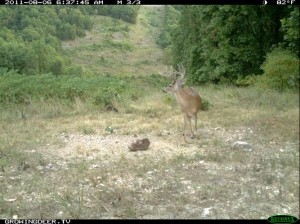
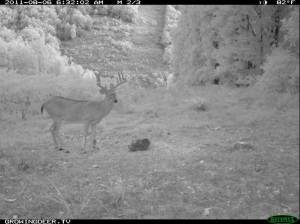 One of my harvest objectives for this fall is Clean 12. Clean 12 is a great buck for several reasons. He’s mature (probably 4 years old or older) based on the shape of his body. Hence, he’s survived at least four hunting seasons (as a 0.5, 1.5, 2.5, and 3.5 year old). There are 34 landowners that border my property. Many of these neighbors and their guests hunt and have different deer harvest objectives than me. Therefore Clean 12 is not easy prey. He has beautiful antlers – especially given there has never been a P&Y or B&C buck recorded in the counties (a county line splits my property) where I hunt.
One of my harvest objectives for this fall is Clean 12. Clean 12 is a great buck for several reasons. He’s mature (probably 4 years old or older) based on the shape of his body. Hence, he’s survived at least four hunting seasons (as a 0.5, 1.5, 2.5, and 3.5 year old). There are 34 landowners that border my property. Many of these neighbors and their guests hunt and have different deer harvest objectives than me. Therefore Clean 12 is not easy prey. He has beautiful antlers – especially given there has never been a P&Y or B&C buck recorded in the counties (a county line splits my property) where I hunt.
Those are the primary reasons Clean 12 is on my hit list. Take another look at the images of Clean 12. Did you notice the large wound on his left front leg? I’ve captured more than 50 images of Clean 12 this August during my annual camera survey. I never detected any sign of impaired mobility, leakage from the wound, etc., from those images. If I told you I was trying to harvest Clean 12 because he was suffering from injuries, I’d be lying – probably to myself more than to you.
I was (and still am) a hunter before I was a biologist. I’m thrilled that my hunting is a great tool to help improve deer herds! My family really enjoys the venison and time spent in a deer stand is very medicinal to the members of my family and me. Come September 15 (opening day for deer season in Missouri), I’ll be ready to begin my fall deer management activities.
Growing Deer together,
Grant
Antler Growth
There can be no argument that man has been intrigued by antlers and antler growth since the beginning of time. Antlers were the frequent subject of paintings, carvings, etc., by prehistoric man. I’ve yet to meet the child that didn’t accept an antler from my hand when offered. They tend to study the antler, count the points, rapidly notice the unique characteristics, etc. Almost everyone that visits my home comments on the light fixtures made from antlers or the sheds that Tracy uses to decorate our house. Antlers captivate humans from all cultures.
As a scientist and hunter, antlers captivate me. I understand the basics of how antlers are formed – the annual cycle of storing and mobilizing minerals. However, for a critter to grow something the size of a man’s arm and replace it annually is truly a miracle that even science struggles to understand fully.
As a hunter that appreciates creation, the fact that every antler is unique (like a human finger print) is astounding! I just finished the trail camera survey at my property. The unique shape of each buck’s antlers allowed me to identify dozens of unique bucks (from young to old). I wait until mid August to implement trail camera surveys each year so the antlers are developed enough to allow each buck to be specifically identified.
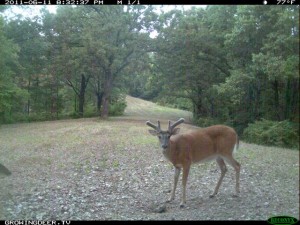 The image on the left taken during June is of a buck I call Clover Mountain Crab Claw. This buck has been present on my property for years. He is at least six years old. His rack has changed from having 8 points to 9 points and back to 8 typical points this year. I can usually accurately identify Clover Mountain Crab Claw by his body – he’s a tank! However, I wait until August to definitively confirm his identify and know that he has survived and avoided me for another year.
The image on the left taken during June is of a buck I call Clover Mountain Crab Claw. This buck has been present on my property for years. He is at least six years old. His rack has changed from having 8 points to 9 points and back to 8 typical points this year. I can usually accurately identify Clover Mountain Crab Claw by his body – he’s a tank! However, I wait until August to definitively confirm his identify and know that he has survived and avoided me for another year.
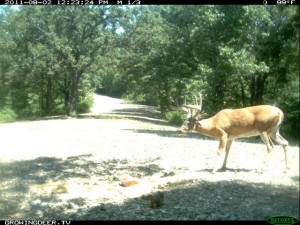 Hunting on the same property year after year allows sportsmen to learn much from the bucks whose range overlaps at least a portion of that property. It allows hunters to learn the general habits of bucks, and if they are good students, the individual movement patterns of each buck. Some bucks have a very large home range. Clover Mountain Crab Claw has a very small home range – as his picture is rarely captured at more than one camera station on my property.
Hunting on the same property year after year allows sportsmen to learn much from the bucks whose range overlaps at least a portion of that property. It allows hunters to learn the general habits of bucks, and if they are good students, the individual movement patterns of each buck. Some bucks have a very large home range. Clover Mountain Crab Claw has a very small home range – as his picture is rarely captured at more than one camera station on my property.
Watching the progress of antlers growing during the summer fascinates me. In addition, it allows me to learn the vast majority of bucks using my property. This is a huge benefit when hunting during the fall and trying to play by my own harvest guidelines. By being very familiar with the antler configuration of most of the 4+ year old bucks I can make rapid decisions of whether to shoot or not when a buck that appears mature comes in range. The thrill of being able to recognize the individual buck and know his estimated age is as fun to me as any other portion of the hunt.
Antlers are mysterious from a science and deer hunter’s point of view. They motivate us to spend gads of hours and resources attempting to learn more and obtain them. There is great value in antlers – and I believe the bulk of this value occurs before the buck is harvested. Those cave paintings have lasted and intrigued man for at least a few thousand years. So this fall when I’m spending many hours attempting to get my hands on a set of mature antlers, feel free to remind me of the joy I’ve already experienced watching one of the great mysteries of creation – watching antlers grow. If Clover Mountain Crab Claw avoids me again this year, I’ll still enjoy searching for his sheds and maintaining good quality habitat so I can see how his antlers develop next summer.
Growing (and chasing) Deer together,
Grant
Harvestable Mature Bucks
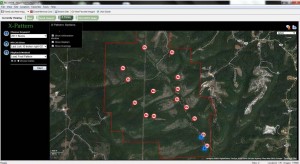
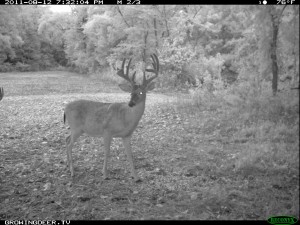 I enjoy studying mature bucks. My Reconyx trail cameras are one of the best tools available to study mature bucks. The cameras themselves don’t spook mature bucks, but there is more to the Reconyx than being a great trail camera. Each camera comes with a free software package, BuckView / MapView, that allows me to easily track the movements and see the pattern of mature bucks. The ability to track where bucks are moving on an aerial image of where I hunt is a tremendous tool.
I enjoy studying mature bucks. My Reconyx trail cameras are one of the best tools available to study mature bucks. The cameras themselves don’t spook mature bucks, but there is more to the Reconyx than being a great trail camera. Each camera comes with a free software package, BuckView / MapView, that allows me to easily track the movements and see the pattern of mature bucks. The ability to track where bucks are moving on an aerial image of where I hunt is a tremendous tool.
I dreamed of tools like this when I was in grad school. However, they were not available or simply cost too much. Now, for the price of a trail camera, I can monitor the movements of mature bucks. Technology is great!

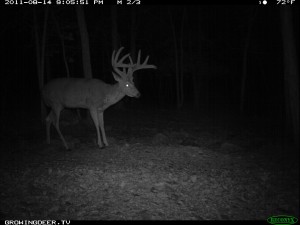 Monitoring the movement of mature bucks does not equate to harvesting a mature buck – but it sure helps. One thing it tells me is the amount of my property a mature buck is using. Some bucks will only use a small portion of a property or have a very small home range. Others mature bucks will have a larger home range or simply use more of the property. This later group includes the bucks that I will focus on while hunting.
Monitoring the movement of mature bucks does not equate to harvesting a mature buck – but it sure helps. One thing it tells me is the amount of my property a mature buck is using. Some bucks will only use a small portion of a property or have a very small home range. Others mature bucks will have a larger home range or simply use more of the property. This later group includes the bucks that I will focus on while hunting.
Bucks are like people – they have different personalities. Some of my friends were raised, got married, and have jobs in the same county where we were born. Others settled far away. As we matured, some of us travel far and wide frequently. Others feel more secure remaining close to their childhood home turf. The same is true with bucks. Each buck has an individual personality. Bucks that have a small range or only use a small portion of the property you hunt can be very difficult to kill. If a buck has a small range, he probably knows every wind current, tree, etc., very well. He can detect change/disturbance to his environment very easily.
Bucks that cover more area probably don’t know each acre nearly as well. In addition, if they are traveling more they are probably crossing more areas that are favorable to hunters (areas where the access, steady wind, etc., favor allowing hunters to select a stand location that won’t alert bucks).
For example, I’m just finishing the annual camera survey at The Proving Grounds. Two mature bucks are using one of my Trophy Rock sites, Last Lick. One of the bucks, Last Lick Right Kicker, only visited the adjoining camera site. He is currently only using a small part of the property where I hunt. I predict I won’t have many encounters with him this fall.
Another mature buck, Last Lick Big 10, is using that same Trophy Rock site and multiple others. When bucks travel relatively far during this time of year, they tend to be moving a lot during hunting season. Although Last Lick Big 10’s pattern may change once he sheds his velvet, I suspect my odds of having an encounter with him this fall are much better!
I’m currently moving my Reconyx units from the location where I do my annual deer herd survey (Trophy Rock locations) to monitoring travel corridors, feeding fields, etc. I’ll use the Reconyx software to track the patterns of these and other bucks. From past research and experience, I’m betting there’s a much better chance my taxidermist meets Last Lick Big 10 than Last Lick Right Kicker. I’ll let you know…
Growing (and hunting) Deer together,
Grant
Antler Growth Patterns
Every year at this time I receive several questions related to how much more antler growth will occur. Folks want to know if a mature buck can add another 20” before velvet shed or what percent of antler development will occur still yet this year.
There is no certain answer for these questions. There are simply too many variables. Two of them are easy to describe. I was one of the tallest kids in my first grade class, if not the tallest. Everyone wanted me on their basketball team during recess. However, by the time I was a freshman in high school, I was only slightly above average height (I’m a tad over 6’ now). No one was screaming for me to be on their basketball team then. Some kids that I was much taller than in first grade were inches taller than me in high school.
I share this information not because I wish to play basketball, but as an illustration about antler development. Some bucks tend to grow more during the early portion of the antler growth season and some add a significant amount of inches during the last few weeks before velvet shed. On average, most bucks are finished adding a significant amount of antler by mid August. However, each buck is a unique individual just like humans are each unique. The best we can do is to manage based on the averages.
Another factor is the growing conditions. The severe drought that is impacting many states throughout the whitetails’ range could certainly limit antler development. Bucks that are feeding on irrigated crops may not show as much reduction in antler development as bucks that live where crop production is extremely limited by lack of water and heat stress.
The other extreme is also true. Bucks that live in areas with a closed canopy forest or other areas where growing season forage is extremely limited may not have significantly less antler development this year compared to normal growing conditions as there simply isn’t much quality forage to limit no matter what the conditions.
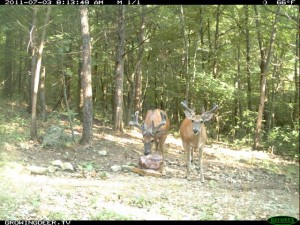
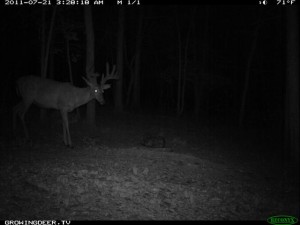 At The Proving Grounds, based on trail camera images, it does seem some of the mature bucks didn’t produce much more antler from last week to this week. I feel comfortable this is because of the extremely harsh drought conditions. The two images are of a buck I named Heavy 10. The images are about 1 week apart, but I can’t tell any increase in antler development. I’ll keep monitoring Heavy 10 and the other bucks for antler growth patterns. How are the bucks developing on your property?
At The Proving Grounds, based on trail camera images, it does seem some of the mature bucks didn’t produce much more antler from last week to this week. I feel comfortable this is because of the extremely harsh drought conditions. The two images are of a buck I named Heavy 10. The images are about 1 week apart, but I can’t tell any increase in antler development. I’ll keep monitoring Heavy 10 and the other bucks for antler growth patterns. How are the bucks developing on your property?
Growing Deer together,
Grant
Scouting for Acorns: Where to Hang Your Treestand
It’s been another very hot day at The Proving Grounds! The thermometer on my truck showed 103 degrees. The native vegetation and food plot crops are showing signs of drought and heat stress. Unless the weather pattern at The Proving Grounds changes before fall, quality food sources will be limited and therefore the few good sources of food will be prime whitetail hunting locations! Acorns are not quality food for deer because they are extremely fibrous and tough to digest. However, deer find them very palatable (tasty) and readily consume acorns from most species of oaks.
Scouting for acorns is a good technique whether you hunt 40 or 4,000 acres. Ideal deer hunting can occur when oak trees are few and far between. This usually occurs when agriculture or other land use practices limit the amount of habitat that is forested. Another situation that produces great hunting is when only a few oaks in an area produce acorns. When these conditions exist, patterning deer may be as simple as lo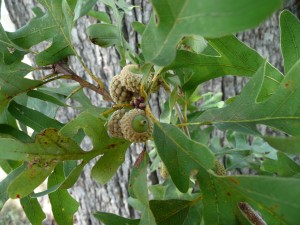 cating the trees that produced acorns and hunting near them without spooking deer.
cating the trees that produced acorns and hunting near them without spooking deer.
However, if oaks are common where you hunt, it can be extremely difficult to see deer during years when all the oak trees produce acorns. This is because deer can eat and bed within an extremely small area. Hunters simply can’t approach these areas without alerting deer! It’s tough to get between the feeding and bedding area when they are literally just a few yards apart.
One nice characteristic of acorns is that they take months to develop. Therefore hunters can scout and place stands during July and August, well before deer season, with confidence that acorns will be present at the same location during hunting season. Knowing which types of acorns deer prefer during the early (from the white oak family) versus late (from the red oak family) season can be a key to hanging stands in locations that fit your hunting schedule. I hope you get some time to scout for acorns soon. Limit disturbance during deer season by scouting and hanging stands now!
Growing Deer together,
Grant



